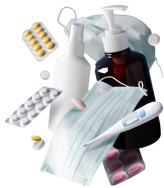-
Description
Levetiracetam is an antiepileptic drug that is effective in seizure control and is well tolerated. This drug interacts with the synaptic vesicle protein 2A (SV2A), its other targets are; calcium homeostasis, the GABAergic system, and AMPA receptors among others, this might lead into a single mechanism of action that explains the antiepileptogenic, anti-inflammatory, neuroprotective, and antioxidant properties of Levetiracetam. So this drug possesses clinical applications other than epilepsy in above explained mechanisms.
-
Ingredients
-
Dosage Form
-
Uses
Levetiracetam is utilized for the following therapeutic indications:
- Adjunctive therapy for partial-onset seizures in adults and children with epilepsy
- Treatment of myoclonic seizures in adolescents and adults
- Management of primary generalized tonic-clonic seizures
-
Dosage
Dose must be taken according to doctor’s advice only; doses given below are suggested as supportive literature for better understanding in some areas of requirements. Adult dose: For Monotherapy of focal seizures with or without secondary generalization: Initial dose is 250mg once daily for 1–2 weeks, then increased to 250mg twice daily, then increased in steps of 250mg twice daily (maximum per dose 1.5g twice daily), adjusted according to response, dose can be increased every 2 weeks. For Adjunctive therapy of focal seizures with or without secondary generalization: Initial dose is 250mg twice daily, then increased in steps of 500mg twice daily (maximum per dose 1.5g twice daily), dose can be increased every 2–4 weeks. For Adjunctive therapy of myoclonic seizures and tonic-clonic seizures: Initial dose is 250mg twice daily, then increased in steps of 500mg twice daily (maximum per dose 1.5g twice daily), dose to be increased every 2–4 weeks. Child dose: For Monotherapy of focal seizures with or without secondary generalization: In children of age 16–17 years: Initial dose is 250mg once daily for 1 week, then increased to 250mg twice daily, then increased in steps of 250mg twice daily (maximum per dose 1.5g twice daily), adjusted according to response, dose to be increased every 2 weeks. For Adjunctive therapy of focal seizures with or without secondary generalization: In children of age 1–5 months: Initial dose is 7mg/kg once daily, then increased in steps of up to 7mg/kg twice daily (maximum per dose 21mg/kg twice daily), dose can be increased every 2 weeks. In children of age 6 months–17 years (body-weight up to 50 kg): Initial dose is 10mg/kg once daily, then increased in steps of up to 10mg/kg twice daily (max. per dose 30mg/kg twice daily), dose can be increased every 2 weeks In children of age 12–17 years (body-weight 50 kg and above): Initial dose is 250mg twice daily, then increased in steps of 500mg twice daily (max. per dose 1.5g twice daily), dose can be increased every 2–4 weeks. For Adjunctive therapy of myoclonic seizures and tonic-clonic seizures: In children of age 12–17 years (body-weight up to 50 kg): Initial dose is 10mg/kg once daily, then increased in steps of up to 10mg/kg twice daily (maximum per dose 30mg/kg twice daily), dose can be increased every 2 weeks. In children of age 12–17 years (body-weight 50kg and above): Initial dose is 250mg twice daily, then increased in steps of 500mg twice daily (maximum per dose 1.5g twice daily), dose can be increased every 2 weeks.
-
In case of Overdose
Overdose of levetiracetam may cause extreme drowsiness, agitation, aggression, shallow breathing, weakness, or fainting. Consult your doctor in case of overdose, he should maintain airway function first then elimination of unabsorbed drug can be done by emesis or gastric lavage.
-
Missed Dose
If you miss any dose then take the dose as soon as you remember, but if it's the time for the next dose then do not double the dose.
-
How To Use
Infused intravenously by a healthcare professional under the instructions of your doctor. Levetiracetam (Anti Seizure medication) should not be discontinued abruptly due to the possibility of increasing seizure frequency and status epilepticus; therapy should be withdrawn gradually to minimize the potential of increased seizure frequency, unless in the case if safety concerns require a more rapid withdrawal.
-
When Not to Use
Do not use in case of hypersensitivity to levetiracetam or any component of the formulation.
-
Side Effects
Common side effects are: Nausea Skin reactions Vertigo Vomiting Anxiety Appetite decreased Asthenia Abnormal Behavior Cough Depression . Diarrhea Dizziness Drowsiness Gastrointestinal discomfort Headache Increased risk of infection . Insomnia Mood alterations Movement disorders Uncommon side effects are: Alopecia Impaired concentration Confusion Hallucination Leucopenia Muscle weakness Myalgia Paraesthesia Psychotic disorder Suicidal tendencies Thrombocytopenia Vision disorders Weight changes Rare side effects are: Acute kidney injury Agranulocytosis Hepatic disorders Hyponatraemia Neutropenia Pancreatitis Pancytopenia Personality disorder Rhabdomyolysis Severe cutaneous adverse reactions (SCARs)
-
Precautions & Warnings
The dose should be carefully monitored during pregnancy and after birth, and adjustments should be made on a clinical basis. Fetal growth should be monitored. Levetiracetam can present in breast milk so caution is required with the use in breastfeeding mothers. In case of kidney impairment in children, reduce the dose if the estimated glomerular filtration rate is less than 80mL/minute/1.73m2. In case of kidney impairment in adults Maximum 2g daily if eGFR is 50–80mL/minute/1.73m2. Maximum 1.5g daily if eGFR is 30–50mL/minute/1.73m2. Maximum 1g daily if eGFR is less than 30 mL/minute/1.73m2. In case of severe liver impairment dose adjustment is required, reduction of 50% in severe impairment if creatinine clearance is less than 60 mL/minute/1.73m2.
-
Food Interactions
Kava Kava shrub that is used as a herbal remedy for mood stabilization, anxiety and insomnia treatment, may increase the effects of Levetiracetam. Kratom leaves are used to make, its extracts are used as herbal remedy to treat muscle pain and diarrhea, suppress appetite and relieve cramps. Kratom may increase CNS depressant effects of Levetiracetam.
-
Storage/Disposal
To monitor brain functioning along with the use of this medicine, go for CT- scan. To monitor live function, go for; LFT, Ultrasound. For monitoring Kidney function, go for; Renal Function Test, Ultrasound.
-
Laboratory Screening
decreasing body weight from 70kg to 40kg was predicted to increase the exposure to this drug by 16% in the population.

